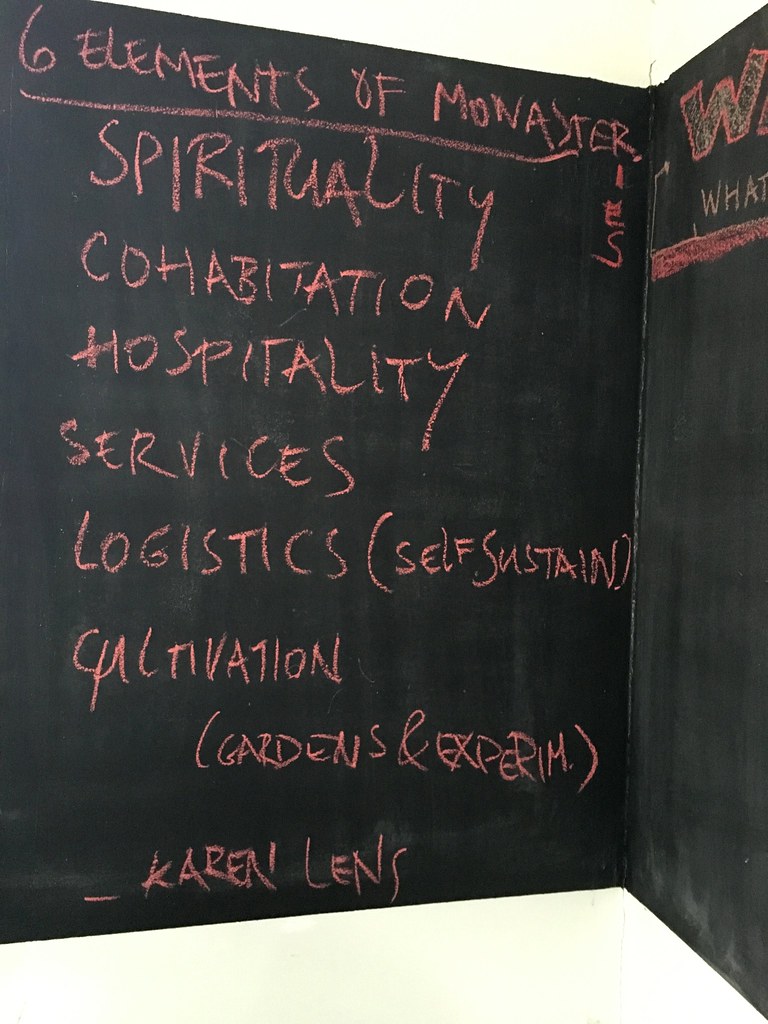Table of Contents
The Outer Monastery
Christian monastic orders
The basic principles of Christian religious community life can be found in Augustine's Rule. The Rule of St. Augustine was written around the year 400. It is the oldest Christian monastic rule that we have today. The Rule of St. Benedict was written approximately 120 years later and The Rule of St. Francis of Assisi was composed more than 800 years later.
St. Benedict's Rule for Monasteries (Regula Sancti Benedicti) is a book of precepts written in 516 by Benedict of Nursia (c. AD 480–550) for monks living communally under the authority of an abbot. Compared to other precepts, it provides a moderate path between individual zeal and formulaic institutionalism; because of this middle ground it has been widely popular. Benedict's concerns were the needs of monks in a community environment: namely, to establish due order, to foster an understanding of the relational nature of human beings, and to provide a spiritual father to support and strengthen the individual's ascetic effort and the spiritual growth that is required for the fulfillment of the human vocation, theosis.
Clare of Assisi (born Chiara Offreduccio and sometimes spelled Clara, Clair, Claire, Sinclair; 16 July 1194 – 11 August 1253) is an Italian saint and one of the first followers of Francis of Assisi. She founded the Order of Poor Ladies, a monastic religious order for women in the Franciscan tradition, and wrote their Rule of Life the first set of monastic guidelines known to have been written by a woman, and following years of struggle, received papal approval in 1253. Following her death, the order she founded was renamed in her honour as the Order of Saint Clare, commonly referred to today as the Poor Clares.
The Monastic Matrix is a scholarly resource for the study of women's religious communities from 400 to 1600 CE
Basilian monks are Catholic monks who follow The Rule of Basil the Great, bishop of Caesarea (330–379). The term Basilian is typically used only in the Catholic Church to distinguish Greek Catholic monks from other forms of monastic life in the Catholic Church. In the Eastern Orthodox Church, as all monks follow the Rule of Saint Basil, they do not distinguish themselves as “Basilian”.
The monastic rules and institutes of Basil are important because their reconstruction of monastic life remains the basis for most Eastern Orthodox and some Greek Catholic monasticism. Benedict of Nursia, who fulfilled much the same function in the West, took his Regula Benedicti from the writings of Basil and other earlier church fathers.
the Greater Asketikon and the Lesser Asketicon.
Latin Rule
The Latin Rule was a document with 72 clauses attributed to Bernard de Clairvaux and Hugues de Payens. It is also known as the “Specific Behavior for the Templar Order”. It outlines the ideal behavior of a knight.
The rule borrowed from the rule of Saint Augustine, but was mostly inspired by the rule of Saint Benedict. It was, however, adapted for use by active, primarily military, knights, rather than cloistered monks. For example, the fasts were less severe so that they did not interfere with combat.
The original rule was written in 1128 and added to the minutes of the Council of Troyes in 1129. However, in about 1138 under the direction of Robert de Craon, second grand master of the order (1136–1149), the rule was translated into French and modified. Later, it was expanded to include 609 articles, notably covering such things as hierarchy and justice within the order.
In January 1128, a council meets in Troyes in Champagne and on the basis of work of Saint Bernard, it grants a primitive rule the Order. This first rule, known as “Latin Rule” was translated, adapted, reformed and supplemented with the passing of years by the publication of the “Withdrawals”.
Buddhist monastic orders
The Pratimokṣa (Sanskrit: प्रातिमोक्ष, romanized: prātimokṣa) is a list of rules (contained within the vinaya) governing the behaviour of Buddhist monastics (monks or bhikṣus and nuns or bhikṣuṇīs). Prati means “towards” and mokṣa means “liberation” from cyclic existence (saṃsāra). The Pratimokṣa is traditionally a section of the Vinaya.
The Theravada Vinaya is preserved in the Pāli Canon in the Vinaya Piṭaka. The Mūlasarvāstivāda Vinaya is preserved in both the Tibetan Buddhist canon in the Kangyur, in a Chinese edition, and in an incomplete Sanskrit manuscript.
Jain Dharma
Jain monasticism refers to the order of monks and nuns in the Jain community and can be divided into two major denominations: the Digambara and the Śvētāmbara. The monastic practices of two the major sects vary greatly, but the major principles of both are identical. Five mahāvratas (Great Vows), from Mahavira's teachings, are followed by all Jain ascetics.
Digambara monks follow 28 vratas (vows): five mahāvratas (Great Vows); five samitis (regulations); the five-fold control of the senses (pañcendriya nirodha); six Şadāvaśyakas (essential duties), and seven niyamas (restrictions).
The main religious premises of the Jain dharma are ahiṃsā (non-violence), anekāntavāda (many-sidedness), aparigraha (non-attachment) and asceticism (abstinence from sensual pleasures). Devout Jains take five main vows: ahiṃsā (non-violence), satya (truth), asteya (not stealing), brahmacharya (sexual continence), and aparigraha (non-possessiveness). These principles have affected Jain culture in many ways, such as leading to a predominantly vegetarian lifestyle. Parasparopagraho Jīvānām (the function of souls is to help one another) is its motto and the Ṇamōkāra mantra is its most common and basic prayer.
Six elements of Monasteries
 | Six elements of Monasteries - Spirituality - Cohabitation - Hospitality - Services - Logistics (self sufficiency) - Cultivation (gardens, experiments, etc) |
Karen Lens (2014) Conservation of monasteries by adaptive reuse: diversified program as a source of inspiration in past and future? http://hdl.handle.net/1942/16566
Islamic perspective
لاَ رَهْبَانِيَّةَ فِي الإِسْلاَمِ.
“There is no (room for) monasticism in Islam” (via Majma'ul Bayan under رهب as also in al-Nihayah of Ibn Kathir)
See also...
Ashrams, intentional communities, Kommuja, Kibbutzim, etc+

